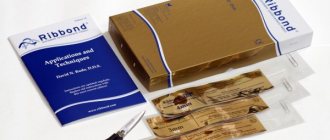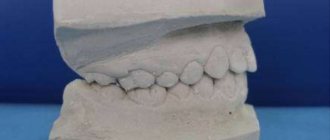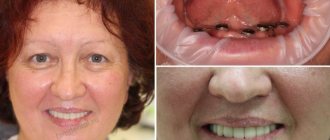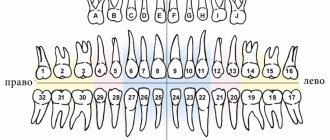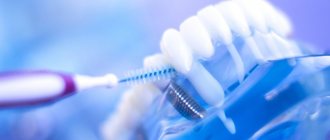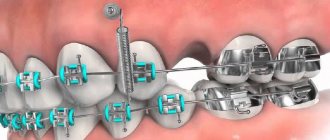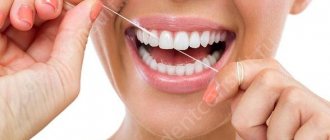8825
An impression or cast of teeth is necessary in the process of prosthetics of any elements of the dentition.
Also, orthodontics cannot do without the use of impressions when creating alignment or bite-correcting systems.
It is used to produce the most precise orthopedic and orthodontic devices.
What it is
In dentistry, casts are models that depict the position of teeth, soft tissues of the oral cavity and jaws. An impression is a hardened material that retains its shape after being removed from the mouth.
They come in different sizes:
- imprint of one or more adjacent teeth;
- imprint of the upper or lower jaw;
- imprint of the entire dentition.
The product, like a negative, displays the contours of the dentition, the outlines of the mucoalveolar cords, the palatal sutures of the hard palate, the frenulum of the lips and tongue.
Several specialists are involved in making impressions: at the initial stage, the impression is made by an orthopedic dentist or orthodontist, and then a dental technician who does not have contact with the patient works with this product. His work takes place in the technical laboratory, from where the model is again transferred to dentistry.
Why is it necessary?
In dentistry, making impressions is necessary during various processes; it becomes a mandatory step when a person is faced with the need to use the following structures:
- Braces are systems necessary for the correction of various pathologies of occlusion and dental arches. Models are made both at the diagnostic stage for a detailed study of all anthropometric parameters of the patient, which are difficult to perform directly in the oral cavity, and for the manufacture of vestibular or lingual fixed braces.
- Retainers . To consolidate the results, after a course of wearing braces, a period of wearing retainers follows, which prevent the teeth from returning to their original position. Retainers are silicone mouth guards made to individual measurements.
- Trainers . Removable orthodontic structures that can be made individually. They are used to eliminate the causes and consequences of dental anomalies. To accurately impact facial aesthetics, detailed studies and accurate measurements of all parameters are required before installing trainers.
- Vestibular plates . To eliminate occlusion imperfections in children, plates are considered one of the most effective means, but this is only possible if all the anatomical characteristics transmitted to the structure through the casts match exactly.
- Removable dentures . In case of an inaccurate match, removable dentures cause a lot of discomfort and can irritate and rub soft tissues, so making the model is a very important step.
- Crowns . If an incisor, canine, premolar or molar is lost, models are made based on polyester mass.
- Bridges . Two manufacturing stages are needed: the first - during the creation of the frame, and the second - for the manufacture of the prosthesis body.
- Implantation . Before implanting the abutment, a model is first made from the impression mass.
Sometimes the manufacture of these products is necessary for home enamel whitening with an individual approach.
An effective way to fix dental implants
An important point is that 3D scanning of teeth can also be used when installing crowns on implants. In this case, it is possible to obtain a digital abutment, which is fixed to the implant in a special computer program. However, it should be remembered that the virtual version is not applicable to all implantation systems. Strauman dental implants are among the most universal designs that have all the necessary virtual copies. In this situation, intraoral examination allows us to determine the shade and shape of the future prosthesis, which will subsequently be installed on the adapter.
Also considered unique is the fact that possible inaccuracies can be avoided and stress factors can be eliminated at the planning stage, when it is necessary to clearly determine the location of the future structure on the bone tissue. This is facilitated by the use of an intraoral 3D scanner, which allows you to take an accurate picture of the jaw and digitally design the area of fixation of the dental implant. Next, with the help of special computer technology, information is supplied to the appropriate device, allowing you to create a template, thanks to which the specialist has the opportunity to fix the implant in the bone tissue as clearly as possible. Based on the above facts, we can conclude that the 3shape Trios scanner plays a vital role in the implantation procedure: it eliminates the risk of any inaccuracies at the planning stage, and also helps prevent errors in the manufacture of the implant prosthesis. As a result, the patient receives a full guarantee of a successful result and gains confidence in the perfection of the dental restoration procedures performed.
Classification
Products made from hardening mass perform many different functions. They differ in various characteristics, so there are several classifications used by dentists:
- by function - anatomical (allows measurements to be taken during physiological rest at the diagnostic stage or for the manufacture of individual structures, devices, devices) and functional (created on the basis of Herbst tests, in which the patient sucks in his cheeks, stretches out his lips, and the models obtained after this , allow you to track changes inside the oral apparatus in dynamics);
- by coverage area - complete (reflecting the entire dental arch with the palate) and partial (reflecting a small section of the dentofacial apparatus);
- by stages of implementation - single-phase (performed in one step) and two-phase (require re-application of the material on the first layer);
- according to the degree of pressure on the palate at the time of making the impression - compression (considerable pressure on the palate to compress and empty the vessels of the mucous membrane) and decompression (without pressure on the tissue of the prosthetic bed).
In recent years, another type has become widespread - digital impressions. This is a completely painless procedure that does not cause discomfort. The execution resembles the usual photography process. A small sensor with a camera on the end is used to read the outline of teeth and surrounding tissue. The data is displayed on the monitor, where it appears in the form of a 3-D model. The likelihood of even the smallest errors with this method is excluded. The only drawback of this method is the high price, since it requires the purchase of expensive equipment and professional software.
Manufacturers of intraoral scanners
Today, there are 7-8 companies widely represented in the world that produce intraoral scanners. Firstly, the ones I talked about. This is CEREC from the German company Sirona, this is the iTero scanner, which is currently produced and owned by Align Technology. This is a company that also makes Invisalign aligners. This is the American company Carestream. This is the European company 3Shape with a TRIOS scanner.
Recently a very worthy scanner has appeared on the market - in terms of scanning quality and convenience, and most importantly, with the most reasonable price. The scanner is called i500. From the Korean company Medit.
Star Smile is a partner of major scanner manufacturers
We, the Star Smile company, have established contact and cooperation with all of the above manufacturers, which allows our clients, when using these scanners, not to have to deal with sending stl files to our company, but simply to create an ID scan number in their personal account, and we, using our agreement, online connection with the servers of scanner manufacturers, we will independently gain access to the intraoral scan, to stl files and will be able to begin production of aligners.
One of our last contracts that we were able to conclude was a contract with Sirona, thanks to which we now have access to CEREC scanners. Any client who owns a CEREC scanner (we are primarily talking about the latest Omnicam models because the previous models are not very suitable for orthodontics, they are mainly intended for orthopedics) can take an intraoral scan of the patient and immediately send this intraoral scan to us at laboratory for the production of aligners.
This is a very important contract for us, because in both Europe and America CEREC occupies a leading position in the intraoral scanning market. I think that up to 50% of our new customers who register on our website in Europe and North America own CEREC scanners.
What other advantages of intraoral scanning for Star Smile clients?
Another advantage is the speed of data exchange between the clinic and us, as manufacturers of aligners.
If the doctor takes traditional impressions of teeth, then in order for us to begin production, these impressions must either be scanned in-house at the clinic, or sent to our office for digital 3D scanning.
Sending dental impressions and the process of scanning them into 3D dental models takes quite a lot of time. On average, it's probably two to three business days.
If the doctor works with an intraoral scanner and has scanned the patient’s oral cavity, then we can begin production of the virtual SetUp as part of the aligner production almost immediately after the doctor has completed the scan and registered the order in our system.
We see that on average this reduces the production time for a virtual SetUp by 2.5 days, which is very good, considering that the average production time for a virtual SetUp is just over 4 days. This means that those clients who start working with intraoral scanning receive a virtual SetUp in two business days, even a little faster.
Another key advantage of intraoral scanning and intraoral scanners over traditional impressions is online control over the quality of the scan, which can be carried out by the doctor.
Let’s imagine such a situation that the doctor took impressions of the teeth, looked at them, and they seemed to him without errors, without flaws. I sent these casts to the laboratory of any manufacturer. And then, during 3D scanning, it turned out that the cast was not of sufficient quality. Somewhere there are braces, for example, somewhere, perhaps, the gingival margin is not “awakened” well enough, somewhere there are air bubbles or saliva. All this affects quality.
When working with traditional casts, this is only visible when casting a plaster model and scanning this plaster model. This is a very painful situation when it turns out that the impression is not of sufficient quality and cannot be used in the production of aligners. This is unpleasant because you have to call the patient to have impressions of his teeth taken, and a lot of time is wasted. We spend at least two or three days taking new impressions and sending them back to 3D scanning and production.
If the clinic works with an intraoral scanner,
then the doctor or his assistant who is engaged in scanning, during the scanning process can visually, on the computer screen, control the quality of the resulting scan, the quality of the digital model. If he sees that there is a mistake somewhere, then this place can be immediately rescanned. This virtually eliminates errors in scans, meaning there is no need to return the patient for rescanning.
Undoubtedly, the intraoral scanner is the most promising and useful technique for 3D dental modeling in the present and near future. But it’s also very expensive. We have diligently avoided the cost of scanners in the article, because now you will be offered a service that will solve your scanning problems without purchasing a scanner. Why buy a scanner, since the cost of intraoral scanners starts from 15 thousand euros? Taking into account all the above advantages, our company Star Smile launched a new service in January 2021, which we call “On-site scanning”.
Materials
There are many more materials being used now than before. A hundred years ago, dentists had only hard materials in their arsenal, but at the moment they have been supplemented and continue to be supplemented with elastic ones.
Solid
Among solid materials, crystalline gypsum is most often used. It has become widespread due to the following advantages:
- availability;
- low cost;
- accurate display of all anatomical parameters.
But in comparison with more modern materials it has the following disadvantages:
- slight shrinkage after moisture evaporation;
- removal from the oral cavity in parts;
- the need to compare different parts, which increases the error;
- impossibility of use with high tooth mobility.
Because of these shortcomings, gypsum is used less and less in orthodontics and orthopedics, and in modern dentistry it has almost gone out of use.
Elastic
At the moment, this type of material is the most progressive, although it has its drawbacks. For example, there is a high risk of deformation after manufacturing. Most elastic materials change color during kneading, which makes it easier to control the preparation of the mixture and allows you to do it quickly and accurately. When choosing, take into account how accurate the display of the gingival parts is necessary.
Orthopedists and orthodontists have the following elastic materials in their arsenal:
- Silicone . There are two types of mixtures: A-silicone and C-silicone. They differ in the reactions of addition and condensation during the solidification of the masses. Silicone has no rival when it comes to accurately representing the tooth ledge and surrounding gum tissue. A-silicone does not require pre-drying of mucous tissues and enamel before application, but it is expensive. C-silicones are used to make one-piece complete structures.
- Alginates . The raw material is seaweed. Such compositions change color when liquid is added, which serves as an indicator of readiness when the desired thickness is reached. After taking the impression, you need to quickly cast the model, since alginates quickly deform.
- Polyesters . Expensive compositions that provide detailed reproduction of the relief of the mucous membrane and dentition.
- Thermoplastic . The condition changes due to exposure to temperature changes. As the temperature rises, softening and increased elasticity occur, and after cooling the product hardens. Thermoplastics are easy to use, provide a tight connection to the impression tray, but the main advantage is that they can be used many times.
- Modeling masses . May consist of paraffin, wax, stearin or mixtures of these substances. They are convenient, allow you to create high-precision impressions, but can become deformed under the influence of heat.
On sale, all these materials are found under different names, which are established by the manufacturer.
Thermoplastic impressions
Casts of this type are produced in the form of disks with a diameter of 100 mm. They melt at a temperature of 70 °C. The disadvantages of the material include the lack of a “guy” and the complexity of making models. In total, there are three types of thermoplastic masses. The first is intended for taking impressions from jaws without teeth, the second is for maxillofacial impressions, and the third is used for the production of splints and pin teeth.
The advantages of thermoplastic include the possibility of metallization and repeated introduction into the oral cavity. It is suitable for the production of functional samples and is easily separated from the models made from them.
There is another group of materials - it includes several types of wax. They are used to make dentures and temporary bridges. But such casts are fragile and can easily become deformed. But at the same time, with the help of such a substance it is possible to perfectly copy the structural features of the dental system.
Manufacturing
Making a dental impression takes place in several successive stages. It includes preparation, taking an impression and directly casting the model.
Preparation
Before taking impressions, some preparation is necessary. If preparation of hard tooth tissues is necessary, local anesthesia is performed. Sometimes surgical preparation is necessary.
Then the doctor selects an impression tray based on the size of the patient’s jaw. There are separate adult and children's sizes. Spoons can be made of metal or other materials. They differ in shape depending on whether they are intended for the upper or lower jaw. To determine the size of the spoon, doctors have special devices that allow them to measure the following parameters:
- jaw shape (curve);
- width of the alveolar process;
- length of the dentition;
- crown height.
In some cases, standard spoons are not suitable. Then the dental technician makes the spoon individually.
Then the oral cavity is prepared, which involves thoroughly drying the moisture. To do this, use cotton swabs to isolate the salivary glands and a special tool - a gun that supplies a stream of air under pressure.
Imprint
The doctor mixes the impression mass to the desired consistency, and then places it in a spoon. The blank is inserted into the mouth and the outline of the future cast is formed with your fingers. The mass is tightly applied and pressed to the place whose imprint needs to be obtained. The force of pressure depends on what function the model will perform. The patient is also asked to close his jaws.
Then the spoon along with the mass is removed from the mouth. If the model is prepared from plaster, then the solid structure inside the oral cavity is divided into several parts, which are taken out in turn and combined outside. Elastic masses allow you to remove the impression at once.
If an impression is needed not of the entire jaw, but only of one tooth, then instead of a spoon, dental rings or metal sleeves are used. The size of these instruments can be adjusted to individual parameters right in the dental office.
After that, the casts are sent to a technical laboratory, where a model of the dentofacial apparatus or crown is made. If the model is needed for detailed diagnostics, it is later returned to the doctor, who will make a conclusion. To manufacture individual systems, the parameters obtained using dental impressions are entered into special programs in order to virtually simulate the future design or predict and demonstrate to the patient the movement of the dentition during treatment.
How much does dental prosthetics cost?
Taking impressions is a mandatory procedure before prosthetics, without which it is impossible to create orthopedic structures for installation. As a rule, this procedure is included in the total cost of prosthetics.
How much does it cost to get dentures?
, depends on various nuances: the type of orthopedic structure chosen for installation, the material for the impression, the complexity of the case and the individual tariffs of the dental center.
We have established affordable prices for prosthetics and dental implants. Medical and surgical procedures are performed by qualified dentists with extensive professional experience, using innovative techniques and high-quality materials from the world's best manufacturers.
How much does dental prosthetics cost:
- removable
dentures – from RUB 17,400; - dental crowns – from RUB 3,300;
- veneers – from 12,000 rubles;
- tabs – from 6500 rub.
More detailed information about prices and services of the center is available on the official website. All patients who leave their reviews on our website are guaranteed to receive a 3% discount on all types of dental services (this is additional and is added to the main discounts available to the client).
Pain during the procedure
Often adults and children are interested in the question of whether it hurts to make impressions. Since during this process the nerve endings in the teeth are not touched, there is no pain.
But some people still experience discomfort. This happens when, after inserting a spoon, the gag reflex is activated. To prevent this reaction, the dentist first inserts the spoon several times and touches it to the roof of the mouth. Repeating these actions allows the patient to get used to the new sensations. Sometimes, as a distraction, a person is recommended to rinse his mouth with cool water after each time he removes a spoon - this helps him not to concentrate on unpleasant sensations.
If all these methods do not help overcome the gag reflex, then the doctor uses special freezing sprays for the mucous membrane, which temporarily dull sensitivity and allow all the necessary actions to be carried out.
Digital orthodontics using 3shape
Modern methods of orthodontic dental treatment are based on the use of not only braces, but also special transparent aligners, which eliminate the fixation of arches and braces on the surface of the teeth. Thus, patients can afford to maintain aesthetic parameters and not be embarrassed by the presence of elements of orthodontic systems visible to the eye. However, these aligners, which form the basis of one of the most modern systems for correcting dental occlusion called “Invisalign,” can only be made by taking impressions from the dentition using impression materials. This method, as we have already discussed above, has certain unpleasant sensations for patients during this procedure and may be accompanied, in some cases, by inaccuracies.
At the same time, the use of technology called 3D scanning of teeth involves eliminating these inconveniences and errors. Scanning teeth using this method also facilitates the possibility of virtually studying the initial closure of teeth and designing a planned change in bite. The presence of the discussed 3shape scanner system will allow for a dynamic comparison of the current situation at various clinical stages of dental occlusion correction with the initial state and the final virtual desired result of treatment.
It should also be noted that scanning teeth using a 3shape scanner will eliminate the possibility of not only errors in designing the design of mouth guards and the desired type of bite, but also a misunderstanding of the rate of change in the curvature of teeth closure.
Thus, this cutting-edge technology will give confidence not only to the doctor, but also to the patient in the rational choice of orthodontic treatment method.
[]
